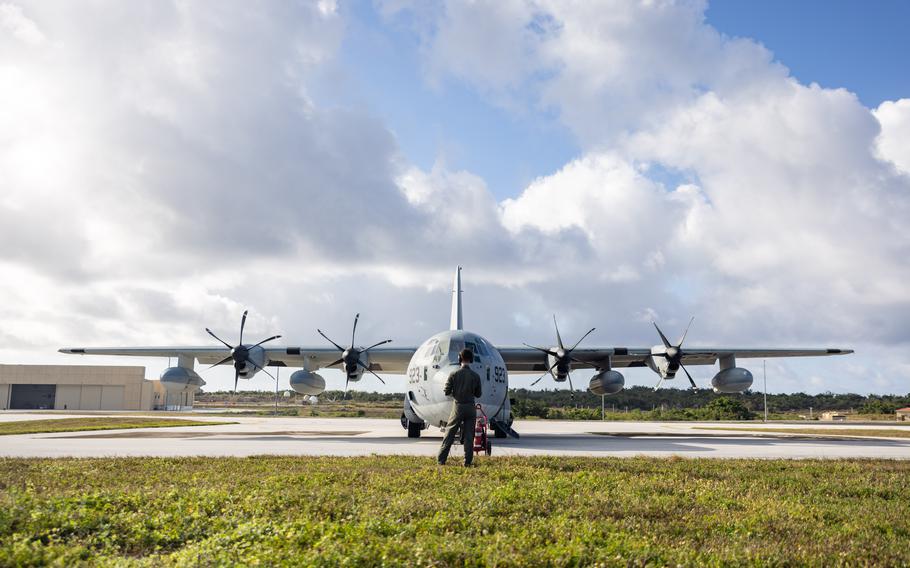
Marine Corps Cpl. Gavin White, a fixed-wing aircraft loadmaster assigned to Marine Aerial Refueler Transport Squadron 152, Marine Aircraft Group 12, 1st Marine Aircraft Wing, runs through a preflight checklist for a KC-130J Super Hercules aircraft at Andersen Air Force Base, Guam, April 21, 2024. (Phuchung Nguyen/U.S. Marine Corps)
WASHINGTON — U.S. military bases in the Indo-Pacific region are sorely lacking hardened aircraft shelters, leaving them vulnerable to devastating airstrikes in a potential conflict with China, lawmakers warned.
Recent war games show the U.S. would lose 90% of its aircraft on the ground, rather than in air combat, due to insufficient base protection, a group of Republican lawmakers wrote in a letter to the secretaries of the Air Force and Navy.
“Unclassified analysis suggests China has enough weapons to overwhelm our air and missile defenses protecting those bases,” they wrote. “Strikes on U.S. bases could immobilize vital air assets, disrupt logistical chains, and significantly weaken our ability to respond in a conflict.”
Rep. John Moolenaar of Michigan, the chairman of the House Select Committee on the Chinese Communist Party, Sen. Marco Rubio of Florida and 11 other lawmakers are urging Pentagon leaders to act.
They are calling for the construction of more hardened aircraft shelters, which are reinforced hangars used to protect military aircraft, as well as underground bunkers and other “passive” defenses.
China has built more than 400 hardened aircraft shelters in the past decade, and the U.S. has only constructed 22 on bases in Japan and South Korea, according to recent research. There are no such shelters in the Northern Mariana Islands or Guam, an island commonly referred to as the “tip of the spear” of U.S. power projection in the Indo-Pacific.
The shelters do not provide complete protection from missile attacks, but they would force China to use more force to destroy each aircraft and increase the survivability of American air assets, lawmakers argued. They acknowledged it might not be feasible or sensible to construct shelters at all U.S. bases in the Indo-Pacific but described the slow pace of construction as “deeply troubling.”
“The limited investment into hardened aircraft shelters is a symptom of a broader problem within the [Defense Department]: We are spending hardly any money on military construction to improve base resilience in the Indo-Pacific,” lawmakers wrote.
U.S. Indo-Pacific Command has provided Congress with a list of $11 billion in priorities that are unfunded under the White House’s 2025 defense budget request, including $3.3 billion in military construction. The Pentagon will spend about 2% of its current construction budget on base resilience projects in the region, less than was spent in 2023, according to the letter.
“If our bases in the Indo-Pacific lack the resilience to survive attacks and continue operating, our ability to deter China and respond quickly in the Taiwan Strait will be greatly diminished,” lawmakers wrote.
The U.S. considers China its greatest competitor and threat and believes Beijing is readying for an invasion of Taiwan, an island China considers its rightful territory. Chinese investment in defense has climbed in recent years, as has its fleet of naval and merchant ships.
China’s growing dominance at sea prompted four lawmakers this week to release congressional guidance for a national maritime strategy. The report notes China has 230 times more shipbuilding capacity than the U.S.
“We must act now, before it is too late, and make a once-in-a-generation investment in the future of America’s maritime power,” said Rep. Mike Waltz, R-Fla.
Underinvestment has reduced the U.S.-flag shipping fleet to fewer than 200 vessels while China boasts more than 7,000 ships, according to the report. America’s maritime industry brings American goods to market but also supports the U.S. military during wartime.
Lawmakers are recommending the U.S. infuse funds into its domestic shipbuilding industry, fully fund and reinvigorate the U.S. Coast Guard and other agencies, prepare for resource competition in the Indo-Pacific with allies and provide the resources necessary to ensure naval forces can defend the freedom of the seas.
“The competition between the United States and Communist China will define the 21st century,” Rubio said.